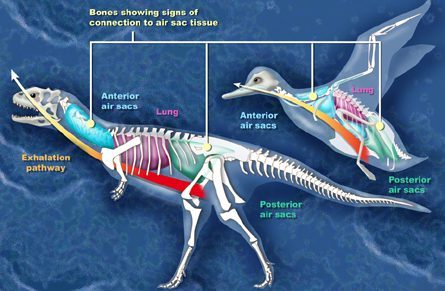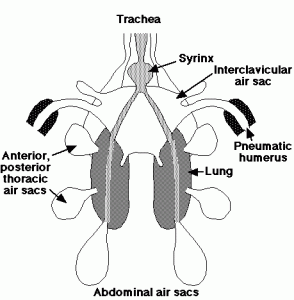Evolution of the bird
Evolution of the bird

Dinosaur and bird respiratory systems Credit: Zina Deretsky, National Science Foundation
Birds evolved from reptiles and are therefore seen as warm-blooded, feathered, flying reptiles. The most commonly held view is that theropod dinosaurs were ancestral to birds and modern flightless birds derived from these earlier flying birds.
Reptiles and birds
Reptiles and birds have many similarities. It is speculated that sometime during bird evolution, environmental temperatures dropped and some reptiles which already possessed a higher metabolism and warm-bloodedness, survived such a harsh climate. This was primarily because they had split scales that enabled them to maintain their internal body temperature by trapping a layer of still, warm air close to their bodies. The beneficial split scales evolved into feathers and these reptiles became ancestral birds. The split scales also aided the birds’ ability to maintain balance during fluttering which, in time, ultimately developed into the ability to fly.
Flight
Some species of ancestral birds possessed characteristics that were more suited to flight than others, such as the ability to lay eggs and the absence of a urinary bladder, which both aided flying. Reproduction by laying eggs meant that the female did not have to carry the added weight of her offspring during embryonic development and the absence of a bladder meant that urine did not accumulate before excretion, thus lightening the load. In fact, the urine passed by birds is of a pasty nature as they re-absorb much of the water, which also reduces their dependence on water supplies. Theropod dinosaurs, like modern birds, possessed air sacs that were connected to their lungs, which permitted efficient oxygen absorption during both inhalation and exhalation. Many also had hollow air-filled or pneumatic bones linked to the air sacs, which improved respiration and permitted the body to be lighter, which also assisted flight.
List of evolutionary changes that enhanced flight
Aspects of evolutionary changes in birds that enhanced their ability to fly are:
- Air sacs and pneumatic bones – the bronchi of the respiratory system extend beyond the lungs into air sacs which in turn extend into many long bones. These air sacs aid flight by:
- reducing the bird’s weight
- helping the bird to change its centre of gravity as it changes posture from the fairly upright when not flying to the generally horizontal posture
- increasing the capacity of the respiratory system for the large volume of air required to provide the oxygen necessary for the energy required for flight
- Major parts of the vertebral column are fused to provide a strong, rigid framework for the large muscles involved in flight.
- The head is attached by a long, flexible, ‘S’ shaped neck as a means of:

Murdoch University - adjusting the centre of gravity during flight
- reducing concussion on landing to protect the brain and nervous system
- facilitate feeding from the ground which would otherwise be difficult because of the rigidity of the body
- The extremely deep sternum, or breast bone, for the attachment of the large muscles that raise and lower the wing during flight.
- The provision of a very simple, but highly efficient, digestive system that, while being light, will support the high metabolic rate.
- The streamlined shape of birds:
- is generally rounded for better aerodynamics
- has folded skin to minimise angles and to eliminate air pockets during flight
- enables the legs to be folded up against the body to minimise their effect on airflow

